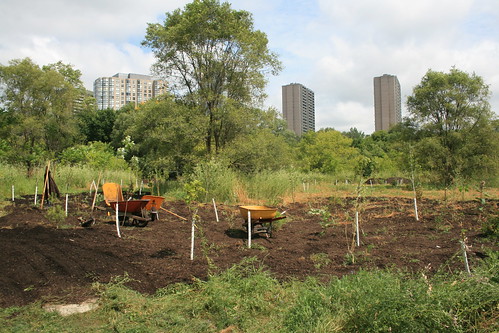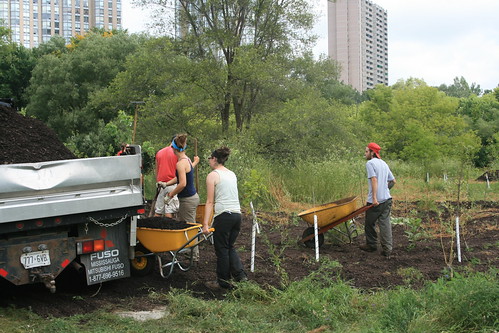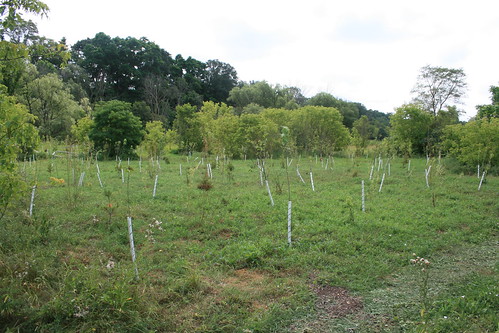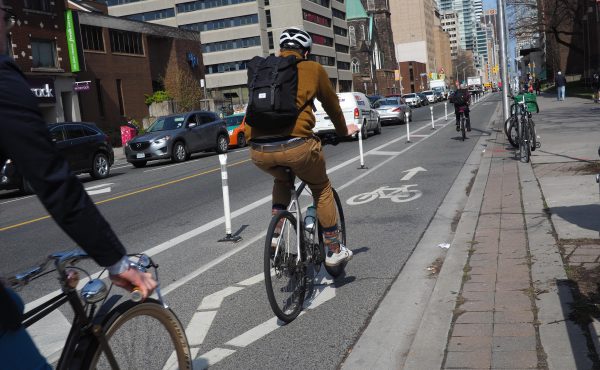It’s 7am on an overcast Wednesday morning. Zoe and her six co-workers stand underneath a tree along the Humber River, surveying their previous day’s work. Thousands of tiny trees sit freshly planted, distinguishable by their protective plastic covering encasing their thin trunks. The mulch is late, causing an unfortunate, but not entirely unwelcome, delay in what is bound to be another long day of labour-intensive tree-planting.
Zoe is employed by Brinkman and Associates Reforestation Ltd., a tree-planting company that employs students and other seasonal workers to plant trees in massive quantities generally in the more remote regions of the country. Although Zoe has previously worked up north in the bush, her current site is Raymore Park, a Humber River flood plain just south of Lawrence Ave. a spot Brinkman has been contracted by the city of Toronto to plant approximately 3,000 trees.
While many of the skill-sets remain the same for urban and rural tree-planting, there are some rather blaring differences. Although Zoe’s commute to sites all over the GTA often takes upwards of an hour, they are all TTC accessible. She also gets to go home and sleep in her own bed at night, see friends, get cell-phone coverage at work and go out at night, unlike many fellow tree-planters working in the remote regions of Ontario, Alberta and British Columbia.
It might sound cushy in comparison to tree-planting in the wild, but there are added challenges to working in urban settings. The Humber river flood plain where Zoe is currently planting is full of stones and concrete rubble likely deposited more than fifty years ago by Hurricane Hazel. Such conditions complicated the process of planting the 3,000 trees now waiting to be mulched.
Other difficulties include smog, hard-to-access sites that are often in less-traveled parts of parks and ravines (the mulch truck must be able to get relatively close to the tree-planting areas) and traffic. While some sites are hard enough to find because of their sheltered locations, others are a little too exposed. As the planting team manager Ashley tells me, last summer many of her days were spent tree-planting on traffic triangles and dividers amidst the deafening drone of cars as they whizzed by on the Gardiner Expressway and QEW.
In comparison, Raymore Park could very well be on the banks of the remote Kesagami River – aside from the high-rise apartment towers looming nearby. The park is relatively quiet, with the rush of the Humber always present in the background.
Recently, Zoe and co. have been doing a lot of planting in Etobicoke, including in West Deane Park, Alex Marchetti Park and other sites along Martin Grove near Eglinton. Because they are on a contract with the city, they have been unaffected by the strike that has seen most outdoor work in public spaces come to a halt. This makes these planters part of an unusually small group of people currently working in Toronto’s parks.
Brinkman and Associates Reforestation Ltd. has been contracted by the City to reforest areas all over Toronto. While in Raymond Park only 3,000 trees have been planted, larger sites around the city have received up to 9,000 new trees. The City of Toronto’s Urban Forestry services department selects the native species to be planted in each area. In the Humber flood plain, oaks, pines, spruce, maple and basswood to name a few species that have been specially chosen for the location.
There are more photos of the site and planters on Flickr.
Photos by Jake Schabas






7 comments
On Eglinton Avenue West in Etobicoke, they had planted some seedlings at several points beside the road. I just wonder that when they start to construct the Eglinton Crosstown LRT, that the seedlings, now saplings, will be transplanted and not plowed under.
Cheers to Zoe and Brinkman! The urban forest needs all the help it can get. If only more people knew that they can get a free street tree in front of their house by contacting Urban Forestry, or a free backyard tree from leaftoronto.org.
Brinkman is one of many companies and NGOs carrying out plantings like this all over the City.
UFORA is another company doing this work and NGOs including FODE (Friends of the Don East); The East Don Parkland Partners; and 10,000 trees for the Rouge.
There are doubtless many others.
Large new plantings this year went in at Rennie Park; Taylor Creek Park, the East Don Parklands, Crothers Woods/Sun Valley, McCowan District Park, and again I’m sure I’m missing several.
Glad to see Raymore is getting done, it needed it!
Yay for contracting out.
Many years ago, one of the early Bring Back the Don plantings went into the north end of Riverdale Park, just south of the swimming pool. It is now a dense, young forest, and every time I go by it, I remember the days when it was a bare hillside, then many freshly planted trees. They take time to grow, but they’re worth it.
@ Steve Munro
Remember when driving along the DVP was like driving through a grass field? I’m glad they stopped cutting the grass and planted trees. Soon it’ll be like driving through a forest. My favourite highway because of this especially when you see towers rising above the trees.
Is it more cost effective for the city to contract out tree planting versus retaining city staff to plant trees?